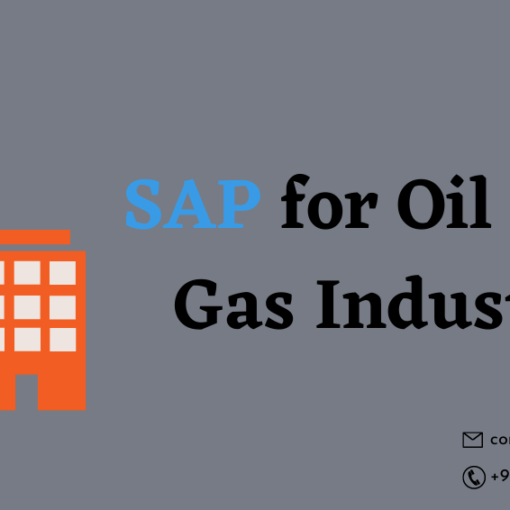One such area where the necessity of strategic planning is a crucial prerequisite for the sustainable sustenance of business is the real estate sector. The significance of proper tool management approaches cannot be disputed in any manner, especially in light of the current state of the economy, which is characterized by mergers, acquisitions, and globalization. In order to significantly improve the bottom line, the SAP EAM (Enterprise Asset Management) (UD2) module incorporates efficient and simple-to-implement Real Estate Management components.
The main economic aspect in real estate is technology, which has an impact on its lifecycle costs, operational efficiency, and sustainability, all while attaining the intended results. Any structure and any business may be intelligent with the correct strategy and tools.
Real estate is thoroughly managed via SAP’s RE-FX (Flexible Real Estate Management) module, which takes into account all business transactions involved in this process. The implementation of this module makes it easier for interested parties—such as tenants, managers, and service providers—to work together. This program for managing real estate transactions is entirely integrated. Both SAP ERP and SAP S/4HANA support the module. You may map all company transactions and operations with SAP RE-FX, whether you’re buying, selling, renting, or building.
Only two additional SAP system components, FI (Accounting) and CO (Controlling), can be used in conjunction with the RE-FX module. Activity in the RE-FX module can now immediately translate into activity in the FI and CO modules thanks to this interaction. We can print invoices and their revisions straight from RE-FX without using the sales (SD) module. Additionally, RE-FX generates letters pertaining to real estate services, including automatic adjustments in rental rates, payment of service fees, payment of turnover-dependent rents, and reminders pertaining to the delivery of turnover from tenants.
Real estate management is empowered by SAP Cloud Platform’s future-proof solutions and makes use of cloud analytics and big data services with exceptional usability, quick setup, and ongoing updates:
SAP Cloud for Real Estate Management Your real estate portfolio is managed centrally via, which also employs embedded analytics to track performance and improve it.
SAP Asset Intelligence Network’s the extension of the digital twin to each asset in the building is made possible by seamless connections to SAP Cloud for Real Estate, SAP S/4 HANA, and SAP ERP.
SAP Project Intelligence Network connects the sharing of project information and connect with a digital twin, creates a single data environment.
What is a real estate management system?
A Real Estate Management System (REMS) is a software solution designed to streamline and automate various processes involved in managing real estate properties, whether they are residential, commercial, or industrial. It is a comprehensive platform that helps real estate companies, property managers, landlords, and investors efficiently handle their properties, tenants, leases, and financial transactions.
Key features of a Real Estate Management System may include:
- Property Listings: The system allows users to create and manage property listings, including details like property type, location, features, images, and pricing.
- Tenant Management: It facilitates tenant screening, lease agreements, rent collection, and maintenance requests.
- Lease and Contract Management: The system helps in creating and managing lease agreements and other contracts related to the property.
- Accounting and Financial Management: REMS often includes accounting modules to handle rent collection, expense tracking, invoicing, and financial reporting.
- Maintenance and Work Orders: It enables tracking and management of property maintenance tasks, repair requests, and work orders.
- Reporting and Analytics: The system provides various reports and analytics to help property managers assess the performance of their properties and make informed decisions.
- Document Management: REMS allows users to store and manage important documents related to properties, tenants, and contracts securely.
- Communication and Notifications: It enables communication with tenants, owners, and other stakeholders via email or other channels.
- Online Payments: Many REMS solutions integrate with online payment gateways, allowing tenants to make rent payments conveniently.
- Mobile Accessibility: Some systems offer mobile apps or responsive interfaces, enabling users to access the platform on the go.
By centralizing all property-related data and processes, a Real Estate Management System improves operational efficiency, reduces paperwork, minimizes manual errors, and enhances overall productivity. It is particularly beneficial for property managers and real estate professionals who handle a significant number of properties or have a large number of tenants to manage.
Key features of SAP RE-FX (SAP in Real Estate)
Real estate objects management
- To create a building pass, building register, or building information model, access a dual view of master data with an architectural view and a usage view.
- Create and maintain any kind of real estate asset, such as a company entity, a building, a rental unit, a rental space, or a rental room.
- Manage real estate assets that belong to other people
contract administration(SAP in Real Estate)
- Manage all agreements pertaining to your real estate portfolio, including as leases (both new and existing), outright purchases and sales, and service agreements.
- Use room bookings and permanent seating arrangements to assign any number of rental items from various corporate entities, structures, or company codes to any given contract.
- Look for unoccupied rental properties and contact potential tenants, or the opposite.
Management and optimization of space(SAP in Real Estate)
- Consider architectural aspects, practical issues, and technical conveniences and features.
- Create flexible space definitions and rent them out from a larger space that is available.
- Make the most of your internal space and occupancy.
- Plan and keep track of your relocations and movements.
The credit side of the lease-in procedures
- Control of cash flows by viewing the lease-in process from the credit side
- Plan the posting of expenses
- Using unique control methods, distribute apportionable costs, which are service charges, to tenants for a specific settlement period.
centralized organizational structures
- Planning and controlling of new building developments, maintenance, and modernization projects, as well as asset management posts and reports, real estate controlling, are all integrated.
- Control the processing of purchase orders and commitments for property upkeep.
- FI-GL, FI-AA, CO, TR, PS-CD, FI-AR, FI-AP, PS, PM/CS, MM, DMS, and others are fully integrated.
management of documents.
- You have control over all papers and correspondence related to real estate business activities thanks to document management functions.
Localization
- For Germany, Switzerland, Austria, Italy, Spain, the Netherlands, Portugal, Hungary, the Czech Republic, Slovakia, France, and other nations, the country-specific functionalities are prepared for deployment.
Benefits(SAP in Real Estate)
- It improves the visibility of consistent and trustworthy data across a variety of corporate real estate tasks.
- It contributes to a decrease in the number of applications, maintenance expenses, and infrastructure support requirements. This is made possible by swapping out scattered and disparate systems with one strong management system that follows a predetermined format.
- This lowers the stock-in-hand vacancy and the vacancy rate.
- It reinforces all project schedules, guarantees on-time deliverables and demonstrates better ways to allocate and manage funds.
- By automating manual and redundant patterns or processes, it also boosts individual productivity.
- an all-encompassing system for real estate management and commercial transactions
- reduction of operating costs and increased expenditure transparency.
- Regarding contracts and portfolios of real estate, there is only one reliable source.
- improved judgment based on continuously updated and unified data.
- through document management.
- improved effectiveness in managing real estate as a whole.
- Reallocate funds to improve your assets’ return on investment (ROA).
- Improve employee productivity and workspace use.
- With native connection into SAP Finance, adhere to new lease accounting rules.





